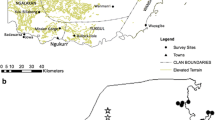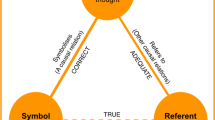Abstract
During the formative period of ethnobotanical studies in the Southwest, Edward Palmer established a standard for reporting useful plants that continues today and Frank. H. Cushing wrote a classic ethnobotany from an anthropological perspective,Z uni Breadstuff. Since these beginnings single tribal studies and, more recently, archaeobotanical investigations have received emphasis. Linguistic studies of plant names and their classification have lagged and synthetic summaries and interpretative explanations of plant use are still demanded. Anthropology’s unique contribution to Southwestern ethnobotany is relating socially shared plant taxonomies and cultural rules for behaving with plants to explain why certain plants are used and others are ignored.
Similar content being viewed by others
Literature Cited
Alexander, H. G., and P. Reiter. 1935. Report on the Excavation of Jemez Cave, New Mexico. School Amer. Res. Monogr. 4, Santa Fe, NM.
Anderson, E., and H. C. Cutler. 1942. Races ofZea mays I: their recognition and classification. Ann. Missouri Bot. Gard. 29: 69–89.
— and F. D. Blanchard. 1942. Prehistoric maize from Canon del Muerto. Amer. J. Bot. 29: 832–835.
Bailey, F. L. 1940. Navajo foods and cooking methods. Amer. Anthropol., n.s. 42: 270–290.
Barrows, D. P. 1900. The Ethno-Botany of the Coahuilla Indians of Southern California. Univ. Chicago Press, Chicago, IL.
Bell, W. H., and E. F. Castetter. 1937. The utilization of mesquite and screwbean by the aborigines in the American Southwest. Ethnobiol. Studies Amer. Southwest V. Univ. New Mexico Bull. 314, Biol. Ser. 5: 3–55.
—. 1941. The utilization of yucca, sotol and beargrass by the aborigines in the American Southwest. Ethnobiol. Studies Amer. Southwest VII. Univ. New Mexico, Bull. 372, Biol. Ser. 5: 1–74.
Berlin, B., D. E. Breedlove, and P. H. Raven. 1974. Principles of Tzeltal Plant Classification. Academic Press, New York.
Berry, M. S. 1982. Time, Space, and Transition in Anasazi Prehistory. Univ. Utah Press, Salt Lake City, UT.
Bohrer, V. L. 1957. Chinchweed(Pectis papposa), a Zuni herb. El Palacio 64: 365.
-. 1968. Paleoecology of an Archaeoological Site Near Snowflake, Arizona. Ph.D. Diss., Dept. Biol. Sci., Univ. Arizona, Tucson, AZ.
— 1970. Ethnobotanical aspects of Snaketown, a Hohokam village in Southern Arizona. Amer. Antiquity 35: 413–430.
Bourke, J. G. 1892. The medicine men of the Apache. U.S. Bur. Amer. Ethnol. Annual Rep. 9: 451–595.
Bryan, K. 1941. Pre-Columbian agriculture in the Southwest, as conditioned by periods of alluviation. Annals Assoc. Amer. Geogr. 31: 219–242.
Bye, R. A. 1972. Ethnobotany of the Southern Paiute Indians in the 1870’s; with a note on the early ethnobotanical collections of Dr. Edward Palmer.In D. D. Fowler, ed, Great Basin Cultural Ecology, a Symposium. Desert Res. Inst. Publ. Soc. Sci. 8: 87–104.
-. 1976. Ethnoecology of the Tarahumara of Chihuahua, Mexico. Ph.D. Diss., Harvard Univ., Cambridge, MA.
— 1979. Incipient domestication of mustards in northwest Mexico. Kiva 44: 237–256.
Carter, G. F. 1945. Plant geography and culture history in the American Southwest. Viking Fund Pub. Anthropol. 5. New York.
—, and E. Anderson. 1945. A preliminary survey of maize in the Southwestern United States. Ann. Missouri Bot. Gard. 32: 297–323.
Castetter, E. F. 1935. Uncultivated native plants used as sources of food. Ethnobiological Studies in the American Southwest I., Univ. New Mexico Bull. 166, Biol. Ser. 4: 1–62.
— 1944. The domain of ethnobiology. Amer. Naturalist 78: 158–170.
—, and W. H. Bell. 1942. Pima and Papago Indian Agriculture. Univ. New Mexico Press, Albuquerque, NM.
—, and W. H. Bell. 1951. Yuman Indian Agriculture, Primitive Subsistence on the Lower Colorado and Gila Rivers. Univ. New Mexico Press, Albuquerque, NM.
—, and M. E. Opler. 1936. The ethnobiology of Chiricahua and Mescalero Apache. Ethnobiological Studies in the American Southwest III, Univ. New Mexico Bull. No. 297, Biol. Ser. 4: 3–63.
—, and R. M. Underhill. 1953. The ethnobiology of the Papago Indians. Ethnobiological Studies in the American Southwest II. Univ. New Mexico Bull. No. 275, Biol. Ser. 4: 1–84.
—, W. H. Bell, and A. R. Grove. 1938. The early utilization and the distribution ofAgave in the American Southwest. Ethnobiol. Studies Amer. Southwest VI. Univ. New Mexico, Bull. 335, Biol. Ser. 5: 3–92.
-. n.d. Pueblo agriculture. Notes on file in the Ethnobotanical Laboratory, University of Michigan, Ann Arbor, MI.
Cook, S. L. 1930. The Ethnobotany of the Jemez Indians. Univ. New Mexico, M.A. Thesis, Albuquerque, NM.
Cushing, F. H. 1920. Zuni Breadstuff. Mus. Amer. Indian, Heye Foundation, New York. Indian Notes and Monogr. 8: 1–673.
Cutler, H. C. 1952. A preliminary survey of plant remains of Tularosa Cave.In P. S. Martin, J. B. Rinaldo, E. Bluhm, H. C. Cutler, and R. Grange, Mogollon Cultural Continuity and Change. Fieldiana: Anthropology 40: 461–479.
—, and T. H. Whitaker. 1961. History and distribution of the cultivated cucurbits in the Americas. Amer. Antiquity 26: 469–485.
Fewkes, J. W. 1896. A contribution to ethnobotany. Amer. Anthropol. 9: 14–21.
Fonner, R. L. 1957. Mammal feces from Danger Cave.In J. D. Jennings, Danger Cave. Mem. Soc. Amer. Archaeol. 14: 303.
Ford, R. I. 1968. An Ecological Analysis Involving the Population of San Juan Pueblo, New Mexico. Ph.D. Diss., Dept. Anthropol., Univ. Michigan, Ann Arbor, MI.
— 1981. Gardening and farming before A.D. 1000: Patterns of prehistoric cultivation north of Mexico. J. Ethnobiol. 1: 6–27.
Harshberger, J. W. 1896. Purposes of ethnobotany. Bot. Gaz. 21: 146–154.
Havard, V. 1881. Sotol. Amer. Naturalist 15: 873–877.
— 1884. The mezquit. Amer. Naturalist 18: 451–459.
Heiser, C. B. 1948. Taxonomic and cytological notes on the annual species ofHelianthus. Bull. Torrey Bot. Club. 95: 512–515.
Hough, W. 1897. The Hopi in relation to their plant environment. Amer. Anthropol., o.s. 10: 33–44.
— 1898. Environmental interrelations in Arizona. Amer. Anthropol., o.s. 11: 133–155.
Jones, V. H. 1931. The Ethnobotany of the Isleta Indians. M.A. Thesis, Univ. New Mexico, Albuquerque, NM.
— 1938. An ancient food plant of the Southwest and plateau regions. El Palacio 44: 41–53.
— 1941. The nature and status of ethnobotany. Chron. Bot. 6: 219–221.
— 1948. A new and unusual Navajo dye(Endothia singularis). Plateau 21: 17–24.
-. 1954. Report Number: 339.In M. F. Lambert, Paa-ko, Archaeological chronicle of an Indian village in north central New Mexico. School Amer. Res. Monogr. 19: 162–163.
-, and R. L. Fonner. 1954. Plant materials from sites in the Durango and LaPlata areas, Colorado.In E. H. Morris and R. F. Burgh, Basket Maker II Sites Near Durango, Colorado. Publ. Carnegie Inst. Wash. 604: 93–115.
—, and E. A. Morris. 1960. A seventh-century record of tobacco utilization in Arizona. El Palacio 67: 115–117.
Kaplan, L. 1956. The cultivated beans of the prehistoric Southwest. Ann. Missouri Bot. Gard. 43: 189–251.
Kent, K. P. 1957. The cultivation and weaving of cotton in the prehistoric Southwestern United States. Trans. Amer. Philos. Soc, n.s. 47: 457–733.
Kidder, A. V., and S. J. Guernsey. 1919. Archaeological Explorations in Northeastern Arizona. Bur. Amer. Ethnol. Bull. 65, Washington, DC.
Kroskrity, P. V. 1978. Inferences from Spanish loanwords in Arizona Tewa. Anthropol. Linguistics 20: 340–350.
Lumholtz, C. 1902. Unknown Mexico. Vol. 1. Scribner’s, New York.
Mangelsdorf, P. C., and R. G. Reeves. 1939. The Origin of Indian Com and Its Relatives. Texas Agric. Exp. Sta. Bull. 574., College Station, TX.
—, and C. E. Smith, Jr. 1949. New archaeological evidence of evolution in maize. Bot. Mus. Leafl., Harvard Univ. 13: 213–260.
Martin, P. S., and F. W. Sharrock. 1964. Pollen analysis of prehistoric human feces, a new approach to ethnobotany. Amer. Antiquity 30: 168–180.
-. 1967. Pollen analysis of prehistoric middens near Ft. Sumner, New Mexico.In A. J. Jelinek, A Prehistoric Sequence in the Middle Pecos Valley, New Mexico. Anthropol. Papers, Mus. Anthropol. Univ. Michigan 31: 130–134.
Mathiot, M. 1962. Noun classes and folk taxonomy in Papago. Amer. Anthropol. 62: 340–350.
Matthews, W. 1886. Navajo names for plants. Amer. Naturalist 20: 767–777.
-. 1891. Navajo dye stuff. Smithsonian Inst. Annual Rep. 1890–1891: 613–615.
Morris, E. H. 1939. Archaeological Sites in the LaPlata District, Southwestern Colorado and Northwestern New Mexico. Carnegie Inst. Wash. Publ. 519, Washington, DC.
Nabhan, G. P. 1982. The Desert Smells like Rain. North Point Press, San Francisco, CA.
Palmer, E. 1871. Food products of the North American Indians. USDA Annual Rep. 1870: 404–428.
Perchonock, N., and O. Werner. 1969. Navaho systems of classification: some implications for ethnoscience. Ethnology 8: 229–242.
Pilcher, W. W. 1967. Some comments on the folk taxonomy of the Papago. Amer. Anthropol. 67: 204–208.
Powers, S. 1874. Aboriginal botany. Proc. California Acad. Sci. 5: 392–396.
— 1877. Tribes of California. Contr. N. Amer. Ethnol. 3: 1–635.
Robbins, W. W., J. P. Harrington, and B. Freire-Marreco. 1916. Ethnobotany of the Tewa Indians. Bur. Amer. Ethnol. Bull. 55, Washington, DC.
Sauer, J. D. 1950. The grain amaranths: a survey of their history and classification. Ann. Missouri Bot. Gard. 37: 561–632.
— 1951. Amaranths as dye plants among the Pueblo peoples. Southwestern Anthropol. 6:412–415.
Schoenwetter, J., and F. W. Eddy. 1964. Alluvial and palynological reconstruction of environments, Navajo Reservoir District. Mus. New Mexico, Papers Anthropol. No. 13. Santa Fe, NM.
Shaul, D. L. 1983. Linguistic models of Pueblo prehistory. Paper, Xlth Int. Congr. Anthropol. Ethnol. Sci., Vancouver, BC.
Stevenson, M. C. 1915. Ethnobotany of the Zuni Indians. Bur. Amer. Ethnol. Annual Rep. 30: 31–102.
Swank, G. R. 1932. Ethnobotany of the Acoma and Laguna Indians. M.A. Thesis, Univ. New Mexico, Albuquerque, NM.
Trager, G. 1939. “Cottonwood-tree,” a Southwestern linguistic trait. Int. J. Amer. Linguistics 9: 117–118.
Vestal, P. A. 1940. Notes on a collection of plants from the Hopi Indian region of Arizona made by J. G. Owens in 1891. Bot Mus. Lean. Harvard Univ. 8: 153–168.
— 1952. Ethnobotany of the Ramah Navaho. Papers, Peabody Mus. Amer. Archaeol. Ethnol. Harvard Univ. 40: 1–94.
Watson, J. B. 1943. How the Hopi classify their food. Plateau 15: 49–53.
Whiting, A. F. 1936. Hopi Indian agriculture I: Background. Mus. Northern Arizona, Museum Notes 8: 51–53.
— 1937. Hopi Indian agriculture II: Seed source and distribution. Mus. Northern Arizona, Museum Notes 10: 13–16.
— 1939. Ethnobotany of the Hopi. Mus. Northern Arizona Bull. 15, Flagstaff, AZ.
— 1966. The present status of ethnobotany in the Southwest. Econ. Bot. 20: 316–325.
Yarnell, R. A. 1959. Prehistoric pueblo use ofDatura. El Palacio 66: 176–178.
Author information
Authors and Affiliations
Rights and permissions
About this article
Cite this article
Ford, R.I. Anthropological perspective of ethnobotany in the Greater Southwest. Econ Bot 39, 400–415 (1985). https://doi.org/10.1007/BF02858747
Received:
Accepted:
Issue Date:
DOI: https://doi.org/10.1007/BF02858747




